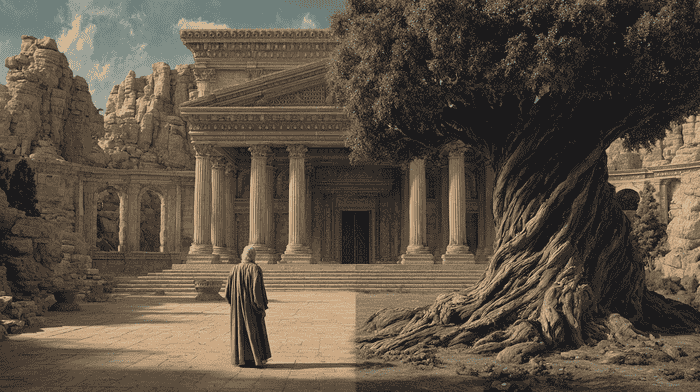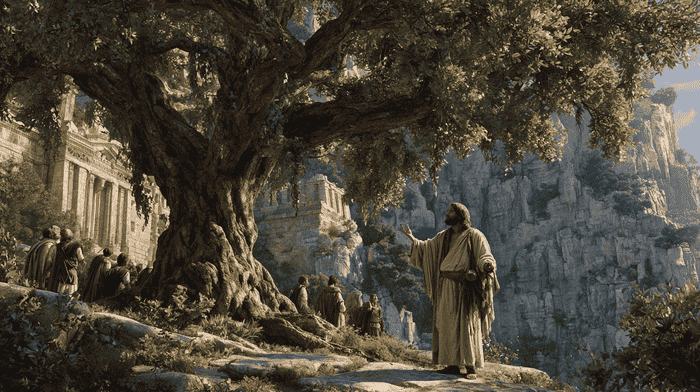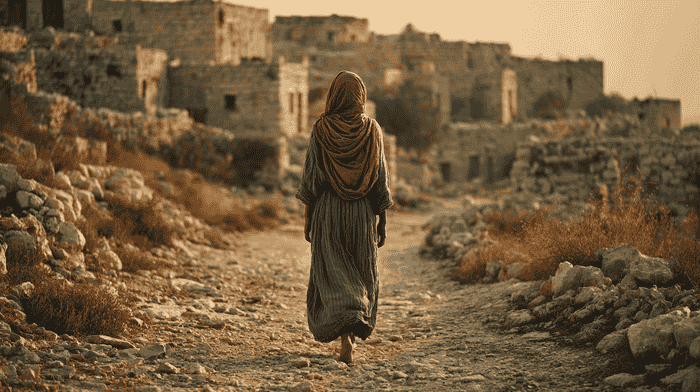The Biblical Accounts: Jesus and the Fig Tree
Matthew 21:18-22 (NRSVCE) describes the scene clearly:
“In the morning, when he returned to the city, he was hungry. And seeing a fig tree by the side of the road, he went to it and found nothing at all on it but leaves. Then he said to it, 'May no fruit ever come from you again!' And the fig tree withered at once.”
Mark 11:12-14 (NRSVCE) adds more detail:
“On the following day, when they came from Bethany, he was hungry. Seeing in the distance a fig tree in leaf, he went to see whether perhaps he would find anything on it. When he came to it, he found nothing but leaves, for it was not the season for figs. He said to it, 'May no one ever eat fruit from you again.' And his disciples heard it.”
This action is followed in Mark by the cleansing of the temple, and the next day the disciples find the tree completely withered (Mark 11:20 NRSVCE).
Why Did Jesus Curse the Fig Tree When It Was Out of Season?
This question leaves many believers scratching their heads in confusion. At first glance, Jesus's cursing of a fig tree for not bearing fruit, even though it was not fig season yet, makes absolutely no sense. It goes against the sacred portrayal of the figure of Christ.
But when you dig a little deeper into both the cultural and biblical context, things start to make more sense. Jesus, as usual, was doing more than meets the eye.
This wasn’t really about the tree
Jesus wasn’t frustrated with nature; He was making a point. Fig trees in that part of the world normally produce early buds (taqsh) even before the main fruit comes in. Those little buds were edible and often picked by travelers.
So when a fig tree had full leaves, it was usually a sign that those early figs were there too. But this one looked alive and fruitful, and had nothing. It gave off all the right signals but produced nothing of substance.
It was a prophetic symbol, something the people around Him would’ve recognized
The Old Testament has plenty of prophets going out of their way to get the message across. Think of Jeremiah burying a ruined belt or Ezekiel lying on his side for over a year.
Jesus was following that same prophetic tradition. The fig tree represented Israel, especially the religious leaders who appeared holy but weren’t bearing the fruit God was looking for.
The message was about spiritual honesty
Jesus wanted people to be honest with themselves and what they believed in. He was able to see through the hypocrisy of false believers. This is why He called the Pharisees “whitewashed tombs”: clean on the outside, but dead inside (Matthew 23:27 NRSVCE).
So, yes, it feels like a jarring moment. But maybe that was the point. The fig tree wasn’t punished for being out of season. It was exposed for pretending to be something it wasn’t.
Get Closer to God Today
4.9
Average Rating
|Over 5 Million Downloads
 Fig Tree in the Bible: Symbol of Israel
Fig Tree in the Bible: Symbol of Israel
The fig tree isn’t just a random plant that shows up in the Gospels. It has a long history in Scripture, and it often says more than we realize at first glance.
In fact, throughout the Old Testament, the fig tree was a common symbol for Israel. It was used to reflect the spiritual condition of the people, whether they were walking in obedience or drifting away from God.
Take Hosea 9:10 (NRSVCE), for instance. God says, “Like grapes in the wilderness, I found Israel. Like the first fruit on the fig tree in its first season, I saw your ancestors.” That’s an image of delight, God looking at His people the way someone might enjoy the first sweet fig of the season. It’s personal. Tender. There’s this sense of joy and promise in that early fruit.
But then contrast that with Jeremiah 8:13 (NRSVCE): “When I wanted to gather them, says the Lord, there are no grapes on the vine, nor figs on the fig tree.” Now the tone has changed. The tree is empty. Fruitless. God’s people, who were meant to bear good fruit, have nothing to show for their calling.
Micah 7:1 (NRSVCE) continues in that same direction: “I have become like one who, after the summer fruit has been gathered, after the vintage has been gleaned, finds no cluster to eat; there is no first-ripe fig for which I hunger” Again, the imagery is clear: a longing for fruit that just isn’t there.
In each of these verses, the fig tree is much more than a plant. It’s a mirror. It reflects Israel’s state of faithfulness, or lack of it. A thriving, fruitful fig tree symbolized blessing and faithfulness. But a barren tree? That usually meant judgment was near.
Jesus picked up this same symbolism in a parable He told in Luke 13:6-9 (NRSVCE). A man plants a fig tree in his vineyard and comes looking for fruit. Year after year, nothing.
Finally, he tells the gardener to cut it down. “Why should it be wasting the soil?” he asks. But the gardener doesn’t give up right away. He asks for more time, one more year to dig around it, to fertilize it, to see if maybe, just maybe, it’ll start bearing fruit.
It’s a powerful picture. On the one hand, it shows us how patient God is. He gives time. He gives care. But it also reminds us that patience isn’t endless. Eventually, fruit is expected.
This parable hits the same theme as the cursed fig tree: God is looking for fruit, not leaves, not appearances, but real evidence of a life rooted in Him.
What Is the Lesson of the Fig Tree in the Bible?
When you sit with all these stories (Jesus cursing the fig tree, the parable in Luke, the Old Testament references) a theme starts to emerge. It’s not about the tree. It’s about us.
First of all, the fruit, the result of efforts, matters. Jesus wasn’t impressed by leaves. He wasn’t looking for appearances. He was looking for evidence of life, of change, of something deep happening in the soul.
We can talk about faith, go to church, know all the right words, and still be spiritually barren.
Second, there is a quiet urgency woven through it all. In the parable, the tree gets another chance, but not an endless string of chances. There’s patience, yes. Grace, absolutely. But also a reminder: we don’t have forever. So what are we doing with the time we’ve been given?
And maybe the hardest part: God sees the truth. Not just the image we project, but the roots, the soil, the fruit, or the lack of it. The fig tree challenges us to be honest with ourselves. To ask: Am I just leafy? Or am I growing?
Spiritual Meaning of the Fig Tree
The fig tree shows up throughout Scripture with layers of meaning.
It often represents prosperity and peace, like in Micah 4:4 (NRSVCE), where everyone sits safely under their vine and fig tree, or during Solomon’s reign (1 Kings 4:25 NRSVCE).
But it also becomes a symbol of judgment when it’s barren or withered, as in Jeremiah 29:17 (NRSVCE).
When Jesus curses the fig tree, all of that symbolism collides. It’s a call to Israel, and to each of us, to take a hard look: are we bearing fruit, or just looking the part?
Get Closer to God Today
4.9
Average Rating
|Over 5 Million Downloads
Did Jesus Kill the Fig Tree?
Yes, physically, the fig tree withered from the roots, just as Mark 11:20 (NRSVCE) tells us. But the real message wasn’t about a tree dying. It was a warning about spiritual emptiness.
In Mark’s Gospel, the story of the fig tree wraps around the temple cleansing on purpose. That structure highlights a connection. The tree, like the temple, looked alive from a distance but was fruitless inside.
Jesus wasn’t just judging the plant; He was actually calling out a system that had lost its heart. The fig tree’s fate foreshadowed what would come to the temple itself: destruction, just decades later.
 What Kind of Tree Was Jesus Crucified On?
What Kind of Tree Was Jesus Crucified On?
Scripture doesn’t tell us what kind of tree the cross was made from. Over the years, people have guessed (some legends say it was a dogwood tree), but that’s tradition, not the Bible. The Gospels simply call it a “cross,” and in a few places, especially in Paul’s letters, it’s referred to as a “tree.”
What matters more than the type of wood is the weight it carried. Galatians 3:13 (NRSVCE) says, “Cursed is everyone who hangs on a tree,” echoing Deuteronomy 21:23 (NRSVCE). Crucifixion wasn’t just a brutal practice; it was considered a sign of being cursed by God. And yet, that’s exactly where Jesus went. He took that curse willingly, for us.
When you think about the fig tree Jesus cursed—fruitless, withered, judged—and then think about the tree of the cross, there’s a connection. Israel was called to bear fruit and didn’t. We’ve all fallen short in that same way. But instead of leaving us in our barrenness, Jesus took it on Himself. He bore the weight of judgment so that we could bear fruit again.
So maybe the question isn’t what kind of tree He died on, but why. And the answer to that is love.
Final Thoughts: Why Did Jesus Curse the Fig Tree?
What are we meant to take from this strange, striking moment with the fig tree?
The tree represents Israel, and, in a broader sense, anyone who claims to belong to God. It was full of leaves, looking healthy from a distance, but there was no fruit. Jesus wasn’t angry at a tree. This was a living parable about empty religion, about faith that looks right on the outside but has no substance underneath.
Even though it wasn’t the season for figs, the tree gave off the impression it had something to offer. That’s the part Jesus addressed, the show without the fruit.
It’s a challenge, not just for first-century Israel but for all of us. What are our lives producing? Are we all leaves and no fruit?
The truth is, Jesus is still looking for fruit today. Not perfection, but evidence of real faith, real transformation. The fig tree reminds us that God sees through appearances, and that’s not meant to scare us. It’s meant to wake us up.
Get Closer to God Today
4.9
Average Rating
|Over 5 Million Downloads
Explore More
If this passage stirred questions or reflection, Bible Chat can help you dive deeper. It offers faithful explanations of even the toughest passages, including the story of the fig tree in the Bible. Explore the fig tree spiritual meaning and more at the Bible Chat.
References
- The Holy Bible, New Revised Standard Version, Catholic Edition. (1996). Ignatius Press.
- GotQuestions.org, "Why did Jesus curse the fig tree?"
- Matthew Henry Bible Commentary on Matthew 21 and Mark 11
Image Sources: Midjourney.com










